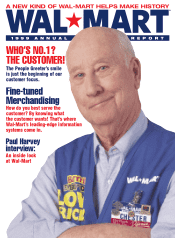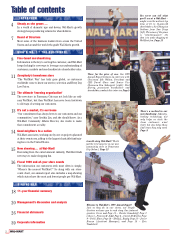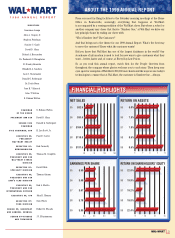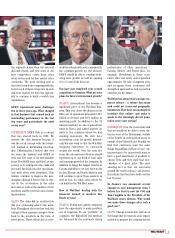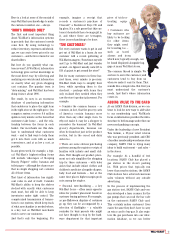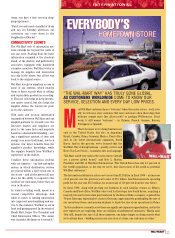Walmart 1999 Annual Report Download - page 9
Download and view the complete annual report
Please find page 9 of the 1999 Walmart annual report below. You can navigate through the pages in the report by either clicking on the pages listed below, or by using the keyword search tool below to find specific information within the annual report.
Here is a look at some of the myriad of
ways Wal-Mart uses knowledge to make
the customer number one – always.
‘WHO’S NUMBER ONE?’
The first and most important thing
about Wal-Mart’s information systems
is precisely that the customer’s needs
come first. By using technology to
reduce inventory, expenses and shrink-
age, we can create lower prices for our
customers – and better returns for our
shareholders.
But how do you quantify what cus-
tomers want? At Wal-Mart, information
technology gives us that knowledge in
the most direct way: by collecting and
analyzing our own internal information
on exactly what any given shopping
cart contains. The popular term is
“data-mining,” and Wal-Mart has been
doing it since about 1990.
The result, by now, is an enormous
database of purchasing information
that enables us to place the right item
in the right store at the right price. Our
computer system receives 8.4 million
updates every minute on the items that
customers take home – and the rela-
tionship between the items in each
basket. Our merchants use this data-
base to understand what customers
want – and to find ways to help them
get it into their carts with as much
convenience, and at as low a cost, as
possible.
In any given week, for example, a typi-
cal Wal-Mart’s highest-selling items
will include videotapes of Sleeping
Beauty, Folgers®coffee, bananas and
toilet paper – although the chances are
that no single shopping cart contains
all of those items.
That kind of information has signifi-
cant value in and of itself. Consider
Wal-Mart’s ability to keep the shelves
stocked with exactly what customers
want most, but still be able to keep
inventories under tight control. The
computerized transmission of transac-
tions to our systems, which keep track
of what merchandise is needed where,
is a key tool as Wal-Mart merchants
work to serve our customers.
And that’s only the beginning. For
example, imagine a receipt that
records a customer’s purchase of
Clearasil,
®a Backstreet Boys CD and
lip gloss. It’s a safe guess that this cus-
tomer’s household has a teenage girl in
it, and where there are teenagers,
there is merchandising to be done.
‘THE CUSTOMER!’
Not every customer wants to get in and
get out of Wal-Mart in a hurry. As one
customer told a recent gathering of
Wal-Mart managers, “Sometimes my wife
and I go to Wal-Mart and just wander
around – we figure it usually costs $15 to
$20 a lap just to get around the store!”
But for many customers in these har-
ried times, every minute is precious.
Wal-Mart finds ways to simplify their
lives, while speeding them to the
checkout – perhaps with items they
only realized they needed when they
saw the store’s product placement. For
example:
•Consider the common banana – so
common, in fact, that the grocery carts
of America contain bananas more
often than any other single item. So
why not make it easy for a shopper to
remember the bananas? In Wal-Mart
grocery departments, bananas can
often be found not just in the produce
section, but in the cereal and dairy
aisles too.
•There are some obvious purchasing
patterns among the register receipts of
families with infants and small chil-
dren. Well thought-out product place-
ment not only simplifies the shopping
trip for these customers – with baby
aisles that include infant clothes and
children’s medicine alongside diapers,
baby food and formula – but at the
same time places higher-margin prod-
ucts among the staples.
•Seasonal merchandising – a key
Wal-Mart focus – offers many opportu-
nities for product placement based on
customer buying patterns. For example,
as pre-Halloween displays of costumes
go up, they can be accompanied by a
selection of flashlights – a valuable
reminder for busy parents who might
not have thought to stop by the hard-
ware department for that important
piece of trick-or-
treating equip-
ment.
•Customers who
buy suitcases are
likely to be looking
for other items
they might need
for traveling too –
such as travel
alarms and irons,
which now, logically enough, can
be found displayed alongside lug-
gage at many Wal-Mart stores.
The common thread is simple: We
are here to serve the customer; and
customers tend to buy from us
when we make it easy for them. That
sounds like a simple idea. But first you
must understand the customer’s
needs. And that’s where information
comes in.
ADDING VALUE TO THE CARD
At our SAM’S Club division, as we con-
tinue to look for new ways to add value
to our membership card, Wal-Mart’s
focus on information provides the infra-
structure to both manage and refine our
new merchandising concepts.
Under the leadership of new President
Tom Grimm, a 25-year retail veteran
who was previously president and CEO
of another membership warehouse store
company, SAM’S Club is trying many
ideas to build excitement – and sales –
in the stores.
For example: At a handful of test
locations, SAM’S Club has placed a
gas station in the store’s parking
lot. With prices that typically run
lower than nearby stations, the SAM’S
Club stations have achieved enormous
sales volumes without any outside
advertising.
In the process of implementing the
gas station test, SAM’S Club and ven-
dors developed a laser scanner for the
gas pumps that can read the bar code
on the customer’s SAM’S Club card.
This certainly makes customers’ lives
easier because they don’t have to carry
an extra card to buy gas. It also regis-
ters the gas purchases into our infor-
mation database, so we can better
9

